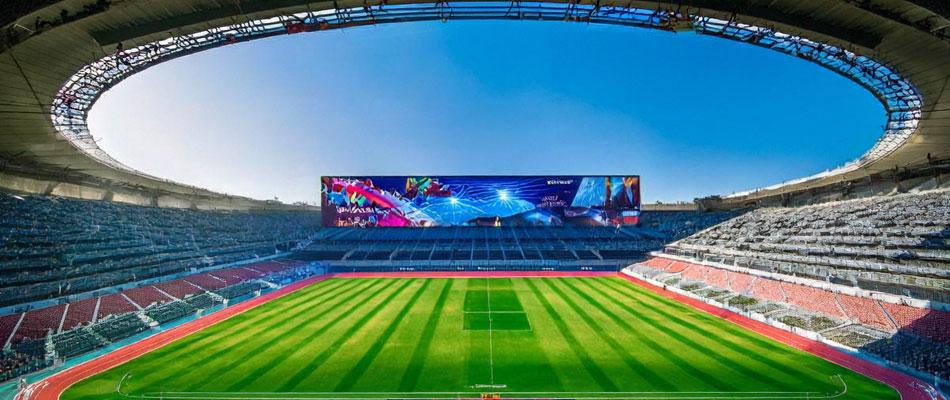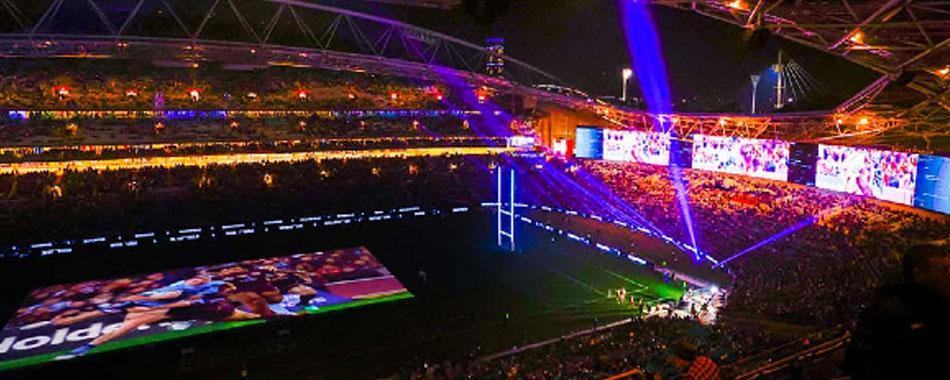The application of LED display screens in modern sports venues has become more and more common, which not only provides audiences with a richer visual experience, but also improves the overall level and commercial value of the event. The following will discuss in detail the five elements of using LED display screens in sports venues.
1. Benefits Of Using LED Screens In Stadiums
1.1 Enhanced Audience Experience
LED screens can broadcast the game scenes and important moments in real time, allowing the audience to clearly see every detail of the game even if they are sitting far away from the stadium. The high-definition picture quality and high-brightness display effect make the audience's viewing experience more exciting and memorable.
1.2 Real-Time Information Update
During the game, the LED screen can update important information such as scores, player data, and game time in real time. This instant information update not only helps the audience to better understand the game, but also enables the organizers of the event to convey information more efficiently.
1.3 Advertising and Commercial Value
LED screens provide an excellent platform for advertising. Companies can increase brand exposure and commercial value by placing advertisements. Event organizers can also increase the profitability of events through advertising revenue.
1.4 Multifunctional Uses
LED screens can not only be used for live broadcasts of games, but also for playing commercials, entertainment programs and game replays during breaks. This multifunctional use makes LED screens an important part of sports stadiums.
1.5 Improve The Level Of Events
High-quality LED screens can improve the overall level of sports events, making the games look more professional and high-end. This has a positive impact on attracting more spectators and sponsors.

2. Basic Elements Of Sports Field LED Display
2.1 Resolution
Resolution is an important indicator to measure the display effect of LED display. High-resolution display can present clearer and more delicate pictures, allowing the audience to better experience the wonderful moments of the game.
2.2 Brightness
Sports venues usually have high ambient light, so the LED display needs to have sufficient brightness to ensure clear visibility under any lighting conditions. High-brightness LED displays can provide better visual effects and enhance the audience's viewing experience.
2.3 Refresh Rate
LED displays with high refresh rates can effectively avoid screen flickering and provide smoother and more fluid display effects. In fast-moving games, high refresh rates are particularly important, allowing viewers to see every detail of the game more clearly.
2.4 Viewing Angle
The audience seats in sports venues are widely distributed, and audiences in different positions have different viewing angle requirements for the display. A wide-viewing angle LED display ensures that the audience can clearly see the display content no matter where they sit.
2.5 Durability
The LED display screens in sports venues need to have high durability and protection capabilities to cope with complex environments and frequent use. Performance requirements such as waterproof, dustproof, and shockproof are important factors to ensure the long-term and stable operation of the display screen.
3. How Do LED Screens Improve The Audience Experience Of Sports Events?
3.1 Provide High-Definition Game Images
High-definition LED display screens can present every detail of the game vividly, making the audience feel as if they are there. This visual experience not only enhances the fun of watching the game, but also increases the audience's sense of involvement in the event.
3.2 Real-Time Playback And Slow Motion
The LED display can play the highlights of the game in real time and slow-motion playback, allowing the audience to repeatedly appreciate and analyze important moments of the game. This function not only increases the interactivity of the audience, but also enhances the viewing value of the event.
3.3 Dynamic Information Display
During the game, the LED display screen can dynamically display key information such as scores, player data, game time, etc., so that the audience can understand the progress of the game in real time. This way of information display makes the viewing process more compact and efficient.

3.4 Entertainment And Interactive Content
During the intervals between games, the LED display screen can play entertainment programs, audience interactive activities and game previews to enrich the audience's viewing experience. This diversified content display not only increases the fun of watching the game, but also improves the audience's participation.
3.5 Stimulate The Audience's Emotions
LED display screens can stimulate the audience's emotional resonance by playing the wonderful performances of the players, the cheers of the audience and the exciting moments of the event. This emotional interaction makes the viewing experience more profound and memorable.
4. What Are The Different Sizes And Resolutions Of LED Display Screens Commonly Used In Sports Venues?
4.1 Large display screens
Large display screens are usually used in the main competition venues of sports stadiums, such as football fields, basketball courts, etc. This type of display screen is usually larger in size and has a higher resolution, which can meet the viewing needs of a large area of audience. Common sizes include 30 meters × 10 meters, 20 meters × 5 meters, etc., and the resolution is usually above 1920 × 1080 pixels.
4.2 Medium display screens
Medium-sized display screens are mainly used in indoor sports stadiums or secondary competition venues, such as volleyball courts, badminton courts, etc. This type of display screen has a moderate size and a relatively high resolution, and can provide high-definition images and information display. Common sizes include 10 meters × 5 meters, 8 meters × 4 meters, etc., and the resolution is usually above 1280 × 720 pixels.
4.3 Small display screens
Small display screens are usually used for auxiliary display or information display in specific areas, such as scoreboards, player information screens, etc. This type of display screen is small in size and relatively low in resolution, but can meet the needs of specific information display. Common sizes include 5 meters × 2 meters, 3 meters × 1 meter, etc., and the resolution is usually above 640 × 480 pixels.
5. What Innovations Are Expected In The LED Display Technology Of Future Stadiums?
5.1 8k Ultra-High-Definition Display Technology
With the development of display technology, 8K ultra-high-definition display screens are expected to be used in future stadiums. This ultra-high-resolution display screen can provide more delicate and realistic pictures, allowing the audience to experience unprecedented visual shock.
5.2 AR/VR display technology
The application of augmented reality (AR) and virtual reality (VR) technology will bring a new viewing experience to sports events. Audiences can enjoy a more immersive and interactive way of watching games by wearing AR/VR devices. The application of this technology will greatly enhance the audience's sense of participation and interactivity.
5.3 Ultra-thin flexible display screen
The emergence of ultra-thin flexible display screens will bring more possibilities to the design and layout of sports venues. This display screen can be bent and folded, and is suitable for various complex environments and venue requirements. Future sports venues can use this technology to display information and interact in more areas.
5.4 Intelligent control system
The application of intelligent control system will make the management and operation of LED display screen more efficient and convenient. Through the intelligent system, the organizer of the event can monitor and adjust the content, brightness, refresh rate and other parameters of the display screen in real time to ensure the best display effect and viewing experience.

5.5 Environmental protection and energy-saving technology
The application of environmental protection and energy-saving technology will make LED display screen more energy-saving and environmentally friendly. Future display screens will adopt more efficient energy conversion technology and environmentally friendly materials to reduce energy consumption and environmental pollution, and contribute to the sustainable development of sports venues.
The application of LED display screens in sports venues not only enhances the audience's viewing experience, but also brings many benefits to the organization and commercial operation of events. With the continuous development of technology, the LED display screens in future sports venues will surely usher in more innovations and breakthroughs, bringing more exciting and unforgettable viewing experience to the audience.
Post time: Sep-06-2024







